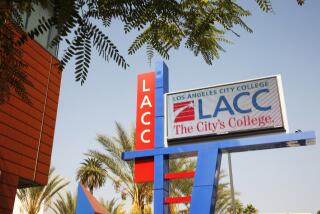First Try at Fund-Raising : Historic Oxford Finds Itself Short of Cash
- Share via
OXFORD, England — Cloistered among its dreaming spires since the Middle Ages, Oxford University has awakened to a nightmare--it’s seriously short of money.
Things have gotten so bad, in fact, that Oxford has been forced to set up the first fund-raising office in its history. Next spring, the proud university will launch a five-year appeal for money from graduates, businesses and foundations around the world.
Reeling from a 14.4% cut in British government financing in real terms since 1980, Oxford is running a deficit of more than $3.3 million a year. Officials say the shortfall is expected to triple by 1992.
As a result, the university has begun what it calls a five-year “retrenchment program,” reducing activities 11% below the 1985-86 base. Fifty-seven academic posts have been eliminated since 1981, and 140 more, about 10% of the current total of 1,459, are to go by 1992.
Other academic posts that become vacant are not filled to save money. This year, the university is not filling two vacant professorial chairs in German and one each in French, Italian and music, said Anne Lonsdale, Oxford’s director of information.
Scientists, meanwhile, complain that they are gravely short of high-technology equipment and support staff, threatening Oxford’s position in research and prompting a brain drain of professors to foreign universities.
Into this grim picture has stepped Dr. Henry Drucker, an American-born political scientist who was appointed in January to head Oxford’s first-ever fund-raising office. He previously held a similar post at Edinburgh University in Scotland.
Drucker has been traveling around the world--New York, Australia, Hong Kong, Japan--laying the groundwork for the fund-raising drive to be launched next spring. It will be called Campaign for Oxford.
Not by U.S. Standards
Although he would not name a figure, Drucker said in an interview that Campaign for Oxford will be “much larger than anything any British university has ever launched.”
But, he said, the campaign “won’t be all that impressive by the standards of the great American universities who are so good at stealing our staff.”
“We start from zero,” Drucker said. “When I walked in here . . . no office, no telephone, no stationery, no mailing list of graduates. . . .
“There’s no budget; there’s me. Moreover, if and when we get all those things, I am still facing a graduate body 80% of whom have never given a penny to their university.”
There are about 100,000 living Oxford graduates. Asked why most of them have never given to Oxford, Drucker said: “Because they’ve never been asked.”
Indeed, penury is something Oxford has never before contemplated.
The university, which received its first charter by papal legate in 1213 and its first gift in 1240--133 pounds from one Robert Grosetest to endow scholarships--has been the beneficiary of massive philanthropy through the centuries. One windfall came from the 19th-Century English empire builder and diamond tycoon Cecil Rhodes, who willed part of his fortune to Oxford to found the Rhodes Scholarship program.
Oxford’s five major museums, including the famous Ashmolean, house priceless art collections, and its buildings are among England’s finest examples of medieval architecture.
In addition, a few of Oxford’s 35 autonomous colleges have built up sizable fortunes through endowments, property holdings and investment income. St. John’s, for one, receives about $1.6 million a year in investment income.
But benefaction and donations account for only 1.4% of the central university’s income these days, and the colleges’ treasures cannot be used to solve its financial plight.
“Christ Church (College) has a wonderful art gallery, but that’s not a capital asset,” Drucker said. “If somebody dies and gives Christ Church a beautiful work of art, that’s because they want Christ Church to have that work of art.
“We don’t have the right to sell that sort of thing. We’re not going to sell it.”
Drucker said the university itself, as distinct from the individual colleges, is responsible for two-thirds of the money spent by Oxford. Much of that goes for faculty salaries and maintaining science laboratories and libraries.
Since it first started accepting government money, along with Cambridge University, in the early 1920s to build up its science program, Oxford has grown more and more tied to the public purse. Cambridge faces many of the same problems but has not announced a fund-raising program.
In 1985-86, government money accounted for 70% of Oxford’s income of $161.9 million. The remainder came from industry research grants, endowments, investments and tuition fees for the 12,500 students. Local governments pay tuition for British students under the country’s socialized education system, while overseas students must pay their own.
Now, Oxford is caught between rising costs and belt-tightening imposed by Prime Minister Margaret M. Thatcher on all of Britain’s 46 state-funded universities in her anti-inflation policy.
More to Read
Sign up for Essential California
The most important California stories and recommendations in your inbox every morning.
You may occasionally receive promotional content from the Los Angeles Times.













